RMAF 2012
Since this is my first piece for the ’zine, let me introduce myself. I’m a dad, an engineer (electrical/audio recording), and an audiophile. I live in the audio nexus of the Midwest, Minneapolis Minnesota, a short bike ride from the Mississippi River. Let’s look back on the RMAF in Denver Colorado, the funnest audio show of the year.
I arrived Thursday afternoon, after an uneventful flight on a small Embraer, and headed over to the venue, where I started walking around the show as vendors prep’d and primped. The first person I ran into was Michal Jurewicz of Mytek, a colleague I’ve worked with several times over the years. At last year’s RMAF, Michal showed a new USB DAC that supports both linear PCM and native DSD. His imaginatively named Stereo192-DSD-DAC ($1595) has an in–built current-feedback headphone amp, FireWire and USB 2.0 interfaces, Word Clock in and out, AES balanced, unbalanced and optical inputs, along with balanced and unbalanced analog outs. He offers two models, differing in that one has additional unbalanced analog ins and the other substitutes those for a pair of DSD inputs on BNC. I missed him last year and was interested in the piece as I have a small DSD collection and know that many record labels have DSD masters in their vaults. The standout exception is Warner as they were riding the ill fated DVD-Audio train, even past its derailment. Only one of my audiophile software players, Pure Music, supports native DSD streams. To add to the conundrum, only a handful of DACs support DSD natively, and Michal’s is the least expensive USB critter. So, as they say on the tellie, “News at 11!” I’ll be working with Mytek on a review.
Of the many rooms/booths I dropped in on once the show started – about forty in total – most were unexciting for one reason or another. The standouts were few and far between but there were many systems that did one or more things well. Not in the standout category was the veritable plethora of Windows-based servers that sprang up at this show like mushrooms after an October rain. One fellow, when asked what OS ran his product, explained that it was running JRiver on (consumer) Win 7 in conjunction with his choice of a spiffy mobo, special AES output interface, et cetera. All sensible if you’re a hobbyist. When asked about the care and feeding required of that Windows rig, he stated something to the effect of, “Sure, once a week you have to do updates…” Once a week?! In a commercial product selling for three kilodollars?! I guess these folks haven’t heard of Windows Embedded and custom drivers, never mind Linux…
Another, er, interesting trend was the seemingly large number of one-way speakers at the show. While most had something flattering you could say about them, fidelity was not generally included in that lexicon. One single driver speaker I did like was Kenji Furukawa’s NF5ex F60 (US$11,342), sporting a 5″ Feastrex – electrodynamic, not permanent-magnet – driven by a 100 Watt McAudi M1002 ($4900) stereo amp. Very laid back and enjoyable, no wonder Furukawa’s company is called Audio Feast! I talked with Kenji about his source, which was a PCM+DSD DAC ($5600) being fed from an Oppo that had been mod’ed to provide a DSD stream out. Both pieces were also from McAudi.
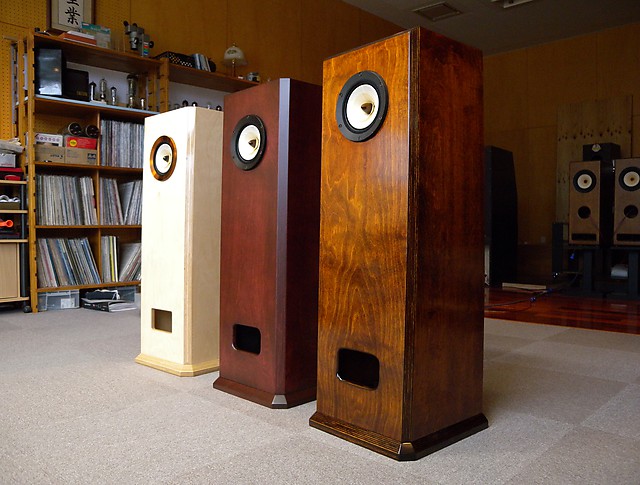
Audio Feast NF5ex F60
Another single driver entrant I finally got to hear was the Voxativ Ampeggio Signature ($32,500). It had a slightly dark but pleasant, easygoing presentation, as driven by KR Audio’s beefy Kronzilla SX ($17,550) class A 50 Watt stereo amp. The source was yet another Win7 server, this one in–house from highend-electronics, the folks whose room it was. The semi–nice thing about the server was the price, $995. The server fed a KR Audio P-130 hollow state pre ($4,950), and the whole rig was connected with Synergistic Research piping. In the same room, they had a static display of a little red brick, the VALVET E1r. It’s a new revision of a single-ended, class A, single-transistor monobloc that delivers 10 watts into an 8 ohm load.
On to the Dali/Naim room, a standout at the show for me. On demo was a pair of the new EPICON 8 ($19,995) connected to a Naim CD5I-2 ($1795) and the new NAC 172XS streaming preamp ($2895) into a NAP 200 ($3295), a 70 Watt stereo amp. The distributor told me that the “streamer portion communicated with the Naim UnitiServe SSD” ($3995) and a Certon Systems Smart Raid NAS ($2495). The whole shebang was wired up with Chord’s new Sarum with Tuned Aray ($7995 for 5 m), and the combination was, as Baby Bear would say, “Just right!” Very clean and open… really loved it but, with so many rooms, I couldn’t get back for an extended listen. I also didn’t get to hear the small EPICON 2 ($7795) two-ways but, based on the voicing of the 8s, the little guys warrant further investigation.
For those of you with a room that serves for both listening and entertaining, and have more than a few kilobucks to spare, there’s the Estelon Model XB ($33,000), whose stylish looks do not detract from the sound quality. My notes say “fractionally recessed mids, finely detailed though slightly narrow soundstage, and tight LF.” Even in the crappy room, these babies provided very good coverage with a huge sweet spot. Designer Alfred Vassilkov attributed this to the tall, very thin cabinet/driver combo. The dark blue XBs were supplied with signal by a pair of Vitus Audio SM-101 and an SL-102 linestage, all cabled together with Kubala-Sosna Elation.
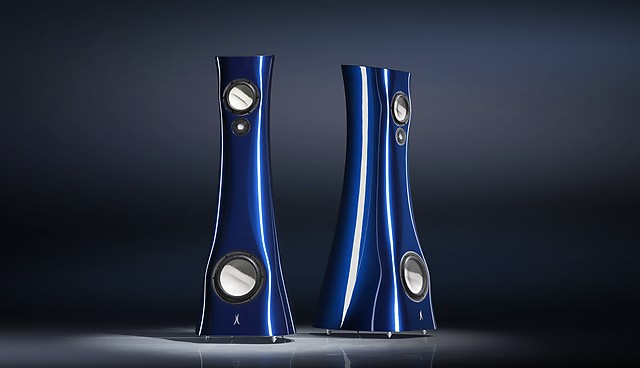
Estelon XB
My colleague Kurt Lassen suggested I drop in on his bud, Lars Kristensen, and get a taste of Raidho’s C 1.1 if they were available. Indeed they were, with Lars deep into his sensible pitch for a “solid foundation” to your system. David Chesky was next to me, and gave Lars a copy of Wycliffe Gordon’s Dreams of New Orleans CD to play. The result, a “wonderfully natural presentation, (with) everything in proportion,” according to my notes. Paradoxically, I found them a “tad dry,” even with the natural wetness of that recording.
Another new brand for me is STUDIO ELECTRIC, makers of a ’20s retro–styled, acoustic suspension two-way ($2650). I noted from a cursory listen that they seemed “dry, with a 4 kHz snap.” The reason I went into their room in the first place was the Benchmark table in their antechamber. Rory Rall was demo’ing the new DAC2 HGC ($1995), a PCM+DSD D–to–A. It’s a featured–packed little dude with about the same form factor as their established DAC1. With a USB class 2–compliant input, as well as four other digital ins and two analog inputs (one balanced), this unit has a crazy number of well thought out features. A new one for me, reflecting Benchmark’s pro audio background, is the digital subsystem’s ability to handle “inter–sample overs,” something I deal with every day at work. Too deep to get into here but, it’s nice they’re thinking through this at the design stage to prevent distortion in the output.
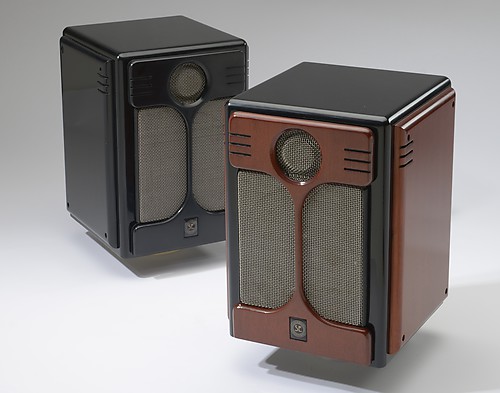
Studio Electric Monitors
Every show, I try to say Hi to Lucien Pichette, the go–to guy at Avalon Acoustics. He and I first met when we worked on the first live DSD/PCM/analog listening test up in Boulder way back when. I was riding herd on the PCM chain, and Lucien provided a “real world” playback environment to compare against the control room monitors. At RMAF, Avalon had a pair of their small Mixing Monitors ($13,000), stand mounted and supplied by a trio of Jeff Rowland’s shiny stuff; his Model 625 Amplifier ($13,500), Corus Pre ($12,800) and Aeris DAC ($9800). The shin bone was connected to the leg bone with fully balanced Cardas Clear Beyond Cabling ($14,000). The Aeris was fed from a dCS Puccini CD player (≈$20,000). These speakers are a consumer voiced version of Avalon’s nearfield studio reference monitor, hence the name. They threw an exceptionally deep and detailed soundstage, with that signature cabinet and truthful Avalon voice.
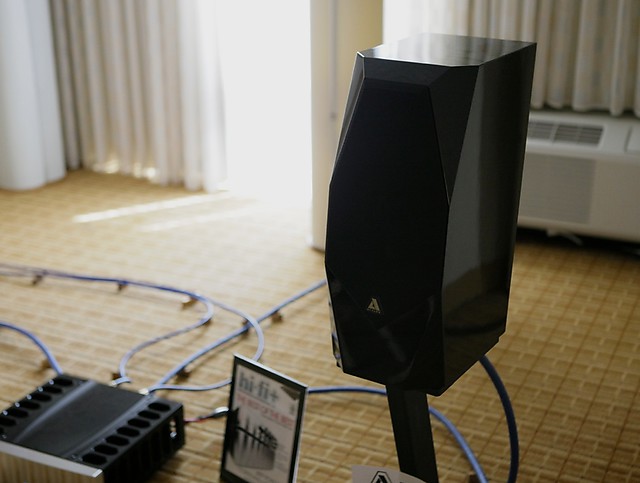
Avalon Mixing Monitors
In the Accent Speaker Tech room, the Marchisotto clan was demonstrating their KO ($9,800) via an Audio Research chain. I’m a fan of their NOLA Micro Grand Reference Series IIs but the KOs, spaced w–a–y apart, were delivering a warm presentation, with recessed upper mids. Their very broad coverage is no wonder considering they are open baffle for mids and highs.
Yet another speaker brand I was unfamiliar with is Jean-Marie Reynaud. The importer, Bob Neill of Amherst Audio, was showing their Abscissa ($5500) sourced from a Resolution Audio Cantata DAC/transport ($6500), a Crimson 710 pre ($7000) and four Crimson 640E monoblocs ($3000), all stitched together with Crimson cabling. The Abscissa small towers were open, very nicely balanced with broad coverage, solid LF and honest mids, all in a narrow footprint.
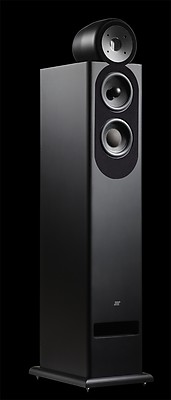
JMR Abscissa
In CanJam Land, I listened to several top shelf in–ear models, from JH Audio, Sennheiser, Ultimate Ears and Westone, along with Audeze’s LCD-3. They were all beautiful, each singing with its own voice. Also talked with L. Eric Rigler, the importer of your home town heroes, Burson Audio. He was showing the new “3 in 1” Conductor ($1850), a DAC+Pre+CansAmp…very promising. Also in CanJam, wildman Jason Stoddard was touting his new Mjolnir balanced headphone amp ($749) and Gungnir USB DAC ($849). Unlike many DACs in that price range, Gungnir is, like the amp, fully balanced. It has a discrete analog output stage, supports 192 k sample rates on its USB input and, it’s USB Audio class 2–compliant for plug and play operation with Mac OS.
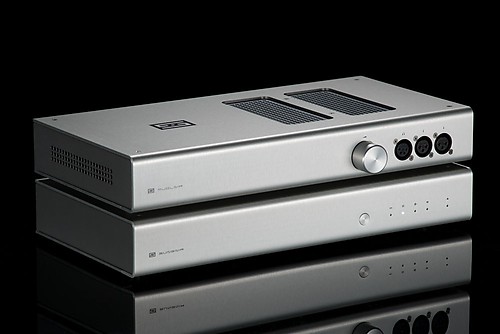
Mjolnir On Top Of Gungnir
Speaking of cans, I got a chance to plug my Etymotics into April Music’s lovely Eximus DP1 DAC ($3200). I stuffed Marta Gomez’s Lucia (96k ALAC), from her Entre Cada Palabra, into Amarra and out through the DP1. Samuel S. Lee, designer of the DP1, told me that the goal was to eliminate the “digitalty” of typical DACs. Though my listening session was brief, as was every aural taste I had at the show, his solid little silver box delivered a clean but musical rendition. This is another DAC with an analog in, so you can use it as a pre. No remote though, kids!
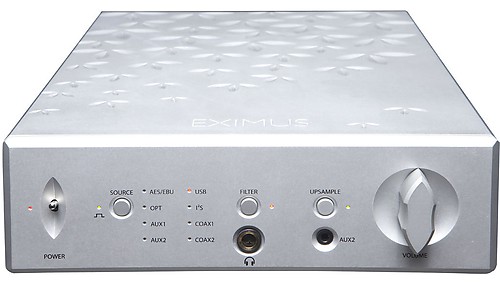
Eximus DP1
There were a couple of good sounding “mid–price” rooms, one from Berlin’s MC music culture technology. I enjoyed the smooth, uncongested sound of their Elegance rig, which consisted of the 192k–capable mc501A CD/USB Dual Player ($3,995), the mc701 integrated amp ($4,595), and the stand–mounted RL21 two-way monitors ($3,495).
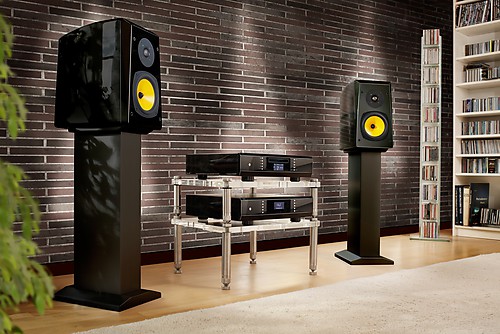
Music Culture Elegance
Even more reasonably priced offerings, free of the overt distortion normally associated with price-conscious systems, were being played by Emotiva Audio and Aperion Audio. It had been a while since I sat down with some Aperion speakers, and was quite surprised at the quality of reproduction. Actually, both product lines were very pleasing to listen to and well within the reach of cash-strapped, entry-level hifi folks.
The last room I’ll mention, filled with MSB electronics and YG Anat III Signature ($119,000) speakers, was another stand out, albeit way at the other end of the price spectrum. Though eye-wateringly expensive, the combo of Amarra feeding a Diamond DAC and Diamond Power Base ($27,990), FemtoSecond Galaxy Clock ($9,950) with Volume Control option ($995), and a pair of M203 class A monoblocs ($27,500) hooked up with Analysis Plus cabling threw a big immersive soundstage, with an ever so slightly warmish midrange, unhyped low end, and outstanding transient response. Let me say that I’m not usually a fan of YG speakers but this combination was magic. MSB also had a static display of their very new (as in the firmware wasn’t out of the oven yet), entry level Analog DAC ($6995) with optional $995 volume control. Vince Galbo, their National Sales Manager who was holding down the fort, said that the new DAC employs technology that “…trickled down from our best Diamond DAC.”
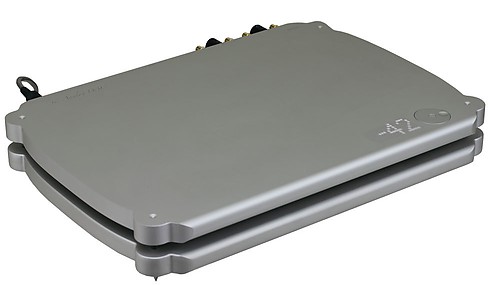
MSB Analog DAC with optional Analog DAC Power Base
There were many more interesting bits of electronics that I’ll report more on in future, like Emotiva Pro’s Stealth DC-1 DAC ($699) and Micromega’s new bargain brute, the $399 MyDac, conçu et fabriqué en France. I got the briefest listen to some surprising speakers, like KEF’s LS50 (loved it alot, gotta do a “bookshelf” roundup) and it’s big brother, Blade (did not love it; “Where’s the phantom image?”, I asked myself).
You may have noticed that I haven’t talked at all about the occasional open reel deck, not to mention the plethora of over-the-top vinyl playback gear. Yes, LPs are enjoyable, but their euphonious colorations don’t get me all hot and bothered. Same goes for tape. I’ve dealt with both at the recording and mastering stage long enough to know there’s nothing special hiding there. Analog is not the holy grail any more than digital is, but digital continues to improve while analog seems to be getting more esoteric and expensive. Ignoring the plentiful if dubious sounding eye candy on offer, this year’s RMAF was a pleasant mix of analog and digital but, I’ll stick with digital, at least for this write up. As a side note, I was talking to one of the show volunteers, who’s selling a Linn Adikt for a hundred bucks…w00t! At that price, I just may upgrade my phono setup!




Hi Oliver,
Just recently watched your earliest audio-phonic effort on the ALP ( Alternate Learning Project) film ( 1973), the high school you attended. Good to hear what a good life you are leading and how you have developed your talent.
Cheers,
Larry
As the kids say these days, OMG!
Hi Larry,
The documentary Kevin and I did on the ALP was what really started me off in this business. Nagras & Arris & Steenbecks, oh my!
Please head over to seneschal.net and drop me a note. I would love to learn more about how you dug up that chestnut…I’ve wondered about that film a loooong time.
All the best,
OMas